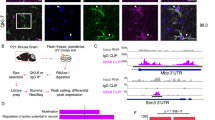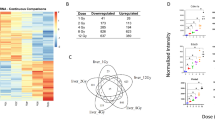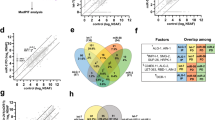Abstract
MicroRNA (miRNA) biogenesis is finely controlled by complex layers of post-transcriptional regulators, including RNA-binding proteins (RBPs). Here, we show that an RBP, QKI5, activates the processing of primary miR-124-1 (pri-124-1) during erythropoiesis. QKI5 recognizes a distal QKI response element and recruits Microprocessor through interaction with DGCR8. Furthermore, the recruited Microprocessor is brought to pri-124-1 stem loops by a spatial RNA-RNA interaction between two complementary sequences. Thus, mutations disrupting their base-pairing affect the strength of QKI5 activation. When erythropoiesis proceeds, the concomitant decrease of QKI5 releases Microprocessor from pri-124-1 and reduces mature miR-124 levels to facilitate erythrocyte maturation. Mechanistically, miR-124 targets TAL1 and c-MYB, two transcription factors involved in normal erythropoiesis. Importantly, this QKI5-mediated regulation also gives rise to a unique miRNA signature, which is required for erythroid differentiation. Taken together, these results demonstrate the pivotal role of QKI5 in primary miRNA processing during erythropoiesis and provide new insights into how a distal element on primary transcripts affects miRNA biogenesis.
Similar content being viewed by others
Log in or create a free account to read this content
Gain free access to this article, as well as selected content from this journal and more on nature.com
or
References
Ameres SL, Zamore PD . Diversifying microRNA sequence and function. Nat Rev Mol Cell Biol 2013; 14:475–488.
Cech TR, Steitz JA . The noncoding RNA revolution-trashing old rules to forge new ones. Cell 2014; 157:77–94.
Yang JS, Lai EC . Alternative miRNA biogenesis pathways and the interpretation of core miRNA pathway mutants. Mol Cell 2011; 43:892–903.
Ha M, Kim VN . Regulation of microRNA biogenesis. Nat Rev Mol Cell Biol 2014; 15:509–524.
Denli AM, Tops BB, Plasterk RH, Ketting RF, Hannon GJ . Processing of primary microRNAs by the microprocessor complex. Nature 2004; 432:231–235.
Gregory RI, Yan KP, Amuthan G, et al. The microprocessor complex mediates the genesis of microRNAs. Nature 2004; 432:235–240.
Nguyen TA, Jo MH, Choi YG, et al. Functional anatomy of the human microprocessor. Cell 2015; 161:1374–1387.
Bartel DP . MicroRNAs: target recognition and regulatory functions. Cell 2009; 136:215–233.
Shukla GC, Singh J, Barik S . MicroRNAs: processing, maturation, target recognition and regulatory functions. Mol Cell Pharmacol 2011; 3:83–92.
Czech B, Hannon GJ . Small RNA sorting: matchmaking for Argonautes. Nat Rev Genet 2011; 12:19–31.
Han J, Lee Y, Yeom KH, et al. Molecular basis for the recognition of primary microRNAs by the Drosha-DGCR8 complex. Cell 2006; 125:887–901.
Auyeung VC, Ulitsky I, McGeary SE, Bartel DP . Beyond secondary structure: primary-sequence determinants license pri-miRNA hairpins for processing. Cell 2013; 152:844–858.
Guil S, Caceres JF . The multifunctional RNA-binding protein hnRNP A1 is required for processing of miR-18a. Nat Struct Mol Biol 2007; 14:591–596.
Trabucchi M, Briata P, Garcia-Mayoral M, et al. The RNA-binding protein KSRP promotes the biogenesis of a subset of microRNAs. Nature 2009; 459:1010–1014.
Chang HM, Triboulet R, Thornton JE, Gregory RI . A role for the Perlman syndrome exonuclease Dis3l2 in the Lin28-let-7 pathway. Nature 2013; 497:244–248.
Heo I, Ha M, Lim J, et al. Mono-uridylation of pre-microRNA as a key step in the biogenesis of group II let-7 microRNAs. Cell 2012; 151:521–532.
Heo I, Joo C, Cho J, Ha M, Han J, Kim VN . Lin28 mediates the terminal uridylation of let-7 precursor microRNA. Mol Cell 2008; 32:276–284.
Fang W, Bartel DP . The menu of features that define primary microRNAs and enable de novo design of microRNA genes. Mol Cell 2015; 60:131–145.
Chen AJ, Paik JH, Zhang H, et al. STAR RNA-binding protein Quaking suppresses cancer via stabilization of specific miRNA. Genes Dev 2012; 26:1459–1472.
Wang Y, Vogel G, Yu Z, Richard S . The QKI-5 and QKI-6 RNA binding proteins regulate the expression of microRNA 7 in glial cells. Mol Cell Biol 2013; 33:1233–1243.
Hafner M, Landthaler M, Burger L, et al. Transcriptome-wide identification of RNA-binding protein and microRNA target sites by PAR-CLIP. Cell 2010; 141:129–141.
Teplova M, Hafner M, Teplov D, Essig K, Tuschl T, Patel DJ . Structure-function studies of STAR family Quaking proteins bound to their in vivo RNA target sites. Genes Dev 2013; 27:928–940.
Zhao L, Ku L, Chen Y, Xia M, LoPresti P, Feng Y . QKI binds MAP1B mRNA and enhances MAP1B expression during oligodendrocyte development. Mol Biol Cell 2006; 17:4179–4186.
Larocque D, Galarneau A, Liu HN, Scott M, Almazan G, Richard S . Protection of p27(Kip1) mRNA by quaking RNA binding proteins promotes oligodendrocyte differentiation. Nat Neurosci 2005; 8:27–33.
Wright PR, Georg J, Mann M, et al. CopraRNA and IntaRNA: predicting small RNA targets, networks and interaction domains. Nucleic Acids Res 2014; 42:W119–W123.
Larocque D, Richard S . QUAKING KH domain proteins as regulators of glial cell fate and myelination. RNA Biol 2005; 2:37–40.
Zhao L, Mandler MD, Yi H, Feng Y . Quaking I controls a unique cytoplasmic pathway that regulates alternative splicing of myelin-associated glycoprotein. Proc Natl Acad Sci USA 2010; 107:19061–19066.
Li Y, Deng C, Hu X, et al. Dynamic interaction between TAL1 oncoprotein and LSD1 regulates TAL1 function in hematopoiesis and leukemogenesis. Oncogene 2012; 31:5007–5018.
Vegiopoulos A, Garcia P, Emambokus N, Frampton J . Coordination of erythropoiesis by the transcription factor c-Myb. Blood 2006; 107:4703–4710.
Thomson JM, Newman M, Parker JS, Morin-Kensicki EM, Wright T, Hammond SM . Extensive post-transcriptional regulation of microRNAs and its implications for cancer. Genes Dev 2006; 20:2202–2207.
Garzon R, Fabbri M, Cimmino A, Calin GA, Croce CM . MicroRNA expression and function in cancer. Trends Mol Med 2006; 12:580–587.
Lu J, Qian J, Chen F, Tang X, Li C, Cardoso WV . Differential expression of components of the microRNA machinery during mouse organogenesis. Biochem Biophys Res Commun 2005; 334:319–323.
Xia H, Yamada S, Aoyama M, et al. Prognostic impact of microRNA-145 down-regulation in adult T-cell leukemia/lymphoma. Hum Pathol 2014; 45:1192–1198.
Yeom KH, Lee Y, Han J, Suh MR, Kim VN . Characterization of DGCR8/Pasha, the essential cofactor for Drosha in primary miRNA processing. Nucleic Acids Res 2006; 34:4622–4629.
Helvik SA . Snove O Jr, Saetrom P . Reliable prediction of Drosha processing sites improves microRNA gene prediction. Bioinformatics 2007; 23:142–149.
Du P, Wang L, Sliz P, Gregory RI . A biogenesis step upstream of microprocessor controls miR-17∼92 expression. Cell 2015; 162:885–899.
Kuchen S, Resch W, Yamane A, et al. Regulation of microRNA expression and abundance during lymphopoiesis. Immunity 2010; 32:828–839.
Conn SJ, Pillman KA, Toubia J, et al. The RNA binding protein quaking regulates formation of circRNAs. Cell 2015; 160:1125–1134.
Yang G, Lu X, Wang L, et al. E2F1 and RNA binding protein QKI comprise a negative feedback in the cell cycle regulation. Cell Cycle 2011; 10:2703–2713.
Zhang Y, Lu Z, Ku L, Chen Y, Wang H, Feng Y . Tyrosine phosphorylation of QKI mediates developmental signals to regulate mRNA metabolism. EMBO J 2003; 22:1801–1810.
Zong FY, Fu X, Wei WJ, et al. The RNA-binding protein QKI suppresses cancer-associated aberrant splicing. PLoS Genet 2014; 10:e1004289.
Yu J, Wang F, Yang GH, et al. Human microRNA clusters: genomic organization and expression profile in leukemia cell lines. Biochem Biophys Res Commun 2006; 349:59–68.
Yu J, Ryan DG, Getsios S, Oliveira-Fernandes M, Fatima A, Lavker RM . MicroRNA-184 antagonizes microRNA-205 to maintain SHIP2 levels in epithelia. Proc Natl Acad Sci USA 2008; 105:19300–19305.
Yin QF, Yang L, Zhang Y, et al. Long noncoding RNAs with snoRNA ends. Mol Cell 2012; 48:219–230.
Gunzl A, Palfi Z, Bindereif A . Analysis of RNA-protein complexes by oligonucleotide-targeted RNase H digestion. Methods 2002; 26:162–169.
Vickers TA, Koo S, Bennett CF, Crooke ST, Dean NM, Baker BF . Efficient reduction of target RNAs by small interfering RNA and RNase H-dependent antisense agents. A comparative analysis. J Biol Chem 2003; 278:7108–7118.
Brantl S, Wagner EG . Antisense RNA-mediated transcriptional attenuation occurs faster than stable antisense/target RNA pairing: an in vitro study of plasmid pIP501. EMBO J 1994; 13:3599–3607.
Overloper A, Kraus A, Gurski R, et al. Two separate modules of the conserved regulatory RNA AbcR1 address multiple target mRNAs in and outside of the translation initiation region. RNA Biol 2014; 11:624–640.
Hsu SD, Tseng YT, Shrestha S, et al. miRTarBase update 2014: an information resource for experimentally validated miRNA-target interactions. Nucleic Acids Res 2014; 42:D78–D85.
Li JH, Liu S, Zhou H, Qu LH, Yang JH . starBase v2.0: decoding miRNA-ceRNA, miRNA-ncRNA and protein-RNA interaction networks from large-scale CLIP-Seq data. Nucleic Acids Res 2014; 42:D92–D97.
Huang da W, Sherman BT, Lempicki RA . Bioinformatics enrichment tools: paths toward the comprehensive functional analysis of large gene lists. Nucleic Acids Res 2009; 37:1–13.
Acknowledgements
We are thankful to Lingling Chen (Institute of Biochemistry and Cell Biology, CAS, China) for the MS2-MBP plasmid, and Bin Zhu (Peking Union Hospital, China) for assistance in umbilical cord blood preparation, and Bo Wen (Fudan University, China) for helpful discussions. J Yu lab is supported by the National Key Research and Development Program of China (2016YFA0100601), the National Key Basic Research Program of China (2015CB94300), the National Natural Science Foundation of China (81530007, 9144011, 31371322 and 31471227) and CAMS Initiative for Innovative Medicine (2016-12M-3-002).
Author information
Authors and Affiliations
Corresponding author
Additional information
( Supplementary information is linked to the online version of the paper on the Cell Research website.)
Supplementary information
Supplementary information, Table S1
List of miRNA candidates involved in the initial screening, related to Figure 1B. (PDF 117 kb)
Supplementary information, Table S2
The real-time PCR results of different transcripts of miRNAs, related to Figure 1B. (XLS 32 kb)
Supplementary information, Table S3
RNA binding protein (RBP) that are predicted to bind primary miR-124-1 (from RBPDB database), related to Figure 2. (XLS 93 kb)
Supplementary information, Table S4
Oligo sequences used in this study. (XLS 60 kb)
Supplementary information, Table S5
Microarry results from GSE30380. (XLS 22 kb)
Supplementary information, Table S6
The real-time PCR results of different transcripts of miRNAs, related to Figure 8C. (XLS 23 kb)
Supplementary information, Table S7
The Gene Ontology analysis of individual and overlapping miRNA targets. (XLS 231 kb)
Supplementary information, Figure S1
The post-transcriptional regulation of miR-124-1 during erythroipoiesis. (PDF 693 kb)
Supplementary information, Figure S2
QKI5 regulates pri-124-1 processing in erythroid cells. (PDF 480 kb)
Supplementary information, Figure S3
QKI5 binds to pri-124-1 transcript. (PDF 218 kb)
Supplementary information, Figure S4
The regulation of QKI5 on pri-124-1 processing is dependent on the QRE. (PDF 107 kb)
Supplementary information, Figure S5
QKI5 acts on the processing of QRE-introduced pri-23a∼27a∼24-2 transcripts. (PDF 228 kb)
Supplementary information, Figure S6
QKI5 and miR-124 are negative regulators for HPCs erythroid differentiation. (PDF 448 kb)
Supplementary information, Figure S7
Functional “rescue assay” in HPCs. (PDF 842 kb)
Supplementary information, Figure S8
QKI5 and miR-124 are negative regulators for in vivo erythroid differentiation. (PDF 215 kb)
Supplementary information, Figure S9
The regulation of multiple miRNAs by QKI5 in erythroid cells. (PDF 1136 kb)
Rights and permissions
About this article
Cite this article
Wang, F., Song, W., Zhao, H. et al. The RNA-binding protein QKI5 regulates primary miR-124-1 processing via a distal RNA motif during erythropoiesis. Cell Res 27, 416–439 (2017). https://doi.org/10.1038/cr.2017.26
Received:
Revised:
Accepted:
Published:
Issue date:
DOI: https://doi.org/10.1038/cr.2017.26
Keywords
This article is cited by
-
Insight into microRNAs’ involvement in hematopoiesis: current standing point of findings
Stem Cell Research & Therapy (2023)
-
A global screening identifies chromatin-enriched RNA-binding proteins and the transcriptional regulatory activity of QKI5 during monocytic differentiation
Genome Biology (2021)
-
A long noncoding RNA binding to QKI-5 regulates germ cell apoptosis via p38 MAPK signaling pathway
Cell Death & Disease (2019)



